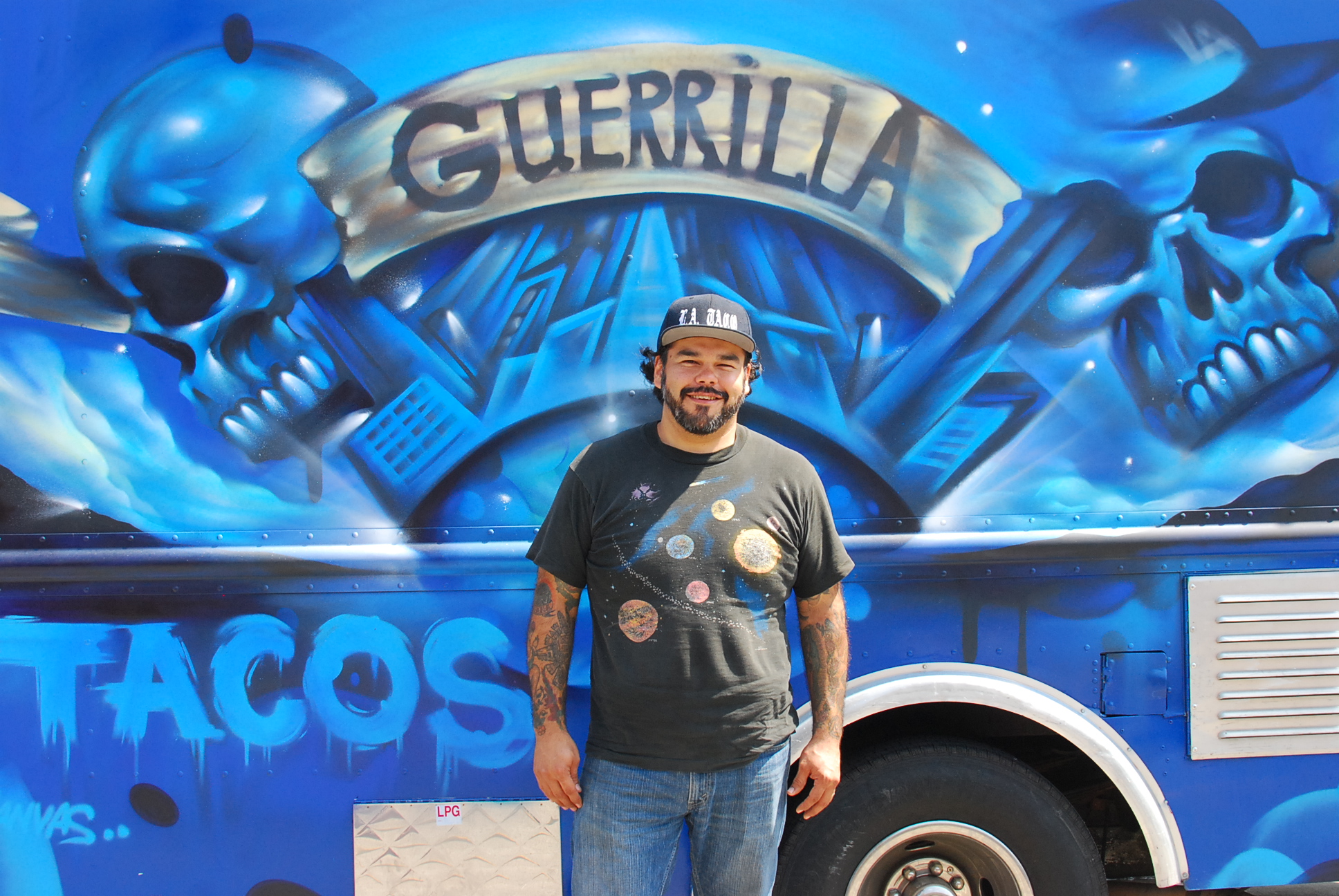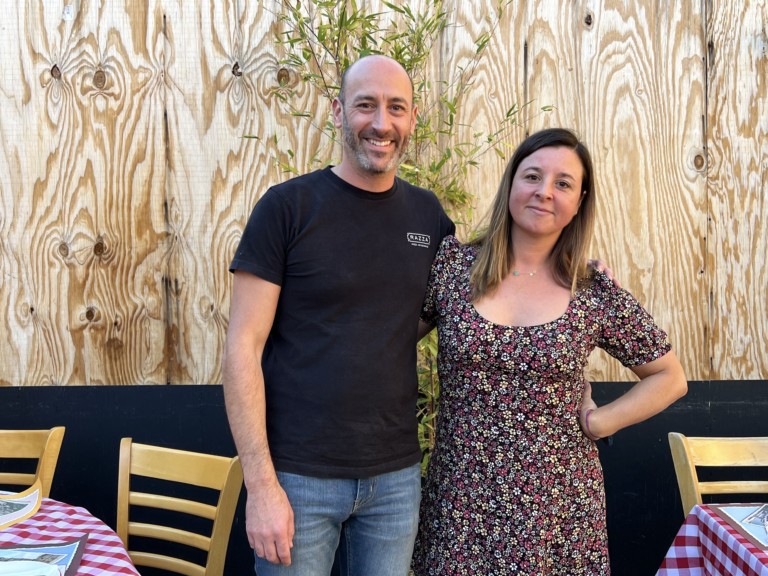INTERVIEW CONTINUED FROM PREVIOUS PAGE
JL: You’re clearly best known for tacos. What are the keys to a great taco?
WA: Really good tortillas. An honest filling. Not trying to do too much. When I get ingredients, in my head, I’m not like, “Oh, I’m going to make this fancy.” I don’t think like that. I think, “What’s the best way I can prepare this one dish?” For instance, I did this dish for this website, and it was one of the simplest dishes I do. It was Santa Barbara stone crab I get from a fishmonger, Stephanie Mutz. She has stone crab and sea urchin. The stone crab, it’s cooked quickly in Court-bouillon. Then I mix that with olive oil, chives, and shallots and put the uni on top of that, and put pickled pineapple on top. It’s a really quick pickle with a lot of lime juice, almost half lime and half sugar with Kaffir lime, galangal and ginger, and just let it sit for an hour. For heat, I like really, really hot stuff, so it’s literally raw habanero, a couple cloves of garlic, a lot of lime and salt. That’s one of my favorite ones.
JL: Your salsas aren’t exactly what you’d find at most taquerias, where you’d get verde, rojo, and maybe some escabeche?
WA: I’ve always taken the approach, like I have with sauces at different restaurants I’ve worked at. These chiles are so unique, it’s much more interesting for me to use them in a way that not necessarily haven’t been done, but put my own spin on it. A lot of these are classic. They have almendrados in Mexico City, and they have different moles, so I figure why not use these different nuts. I have cashews, pistachios, pine nuts, and not all at once. I wouldn’t say have I have crazy complex salsas that have 50, 60 ingredients. A lot of them are six, seven ingredients. It’s just treating them with respect and getting the best I can. If I can get tomatoes at the farmers market, all those bruised ones they have in the corner that say, “Second Quality,” just because you can’t serve them in a salad, these things are fantastic and that’s what I try to use, as much as I can.
JL: Who else in the restaurant industry do you look to for inspiration, guidance or advice?
WA: I’m not past the point where I can get guidance, because I’ve learned a lot from Walter Manzke, Gary Menes, even my chef at the country club I worked at, Milan Pawar. What I learned from Walter, he always said how to treat ingredients with respect. Learn how to cook meat and cook brains and all that stuff with finesse. Seasonality from Gary and Walter. Milan was the one who said, “Do whatever you want.” We’d order stuff. I broke down whole fish. At L’Auberge, we would get one fish per day, one Hamachi. Walter would break it down every time. One time he was busy in a meeting, I broke it down and ruined it. I couldn’t touch fish for the rest of the time I was there. I vowed not to let that happen again. At the country club, he said, “What do you want to do?” I said, “Break down Hamachi.” So he ordered like 10 Hamachi and I learned how to really do it. Practice, practice, practice. Now it’s pretty second nature to be able to break down fish correctly. As far as guidance goes, if I ever have any issues, I can always call those guys up. A lot of the chefs in L.A. are pretty cool dudes. The ones that I’ve talked to and sat down with have been pretty straight-up guys. Once in awhile, you get a person that isn’t that interesting, but for the most part.
JL: Tell the name of the chef and the name of the country club.
WA: It’s Palos Verdes Country Club, and the chef is Milan Pawar…When I came back from L’Auberge, I worked there. I moonlighted there three days a week while I was at Marche, while I was at Palate Food + Wine. That actually paid the bills. A lot of these restaurants pay very little, no matter how much experience you have. I wanted to be in these really good restaurants, so I would basically go to work at 7 a.m. to 2 o’clock at the country club, then drive from Palos Verdes to Glendale, because I lived in Glendale, and work at Palate Food + Wine. I worked 3:30, 4 to 11. I did that five, six days in a row. Work ethic is much instilled in what we do. That’s why, with the truck now, it’s like a 24/7 culture, as opposed to, “This is my job.” It really is a lifestyle. That got me in shape to do this type of work.
JL: You were with Gary Menes for awhile then?
WA: Yeah. I was with Gary at Marche, at Palate, did consulting gigs, then at Le Comptoir. I left Le Comptoir to start Guerrilla Tacos. I bought a cart to do a party at a little park in Glendale, and just invited friends and family. I just want to do tacos at the park. We did that, and I talked to Tyler Wells while I was at Le Comptoir and told him I was interested in doing this. He said, “Bring your little cart over. Heirloom LA isn’t setting up here anymore on Wednesdays at the farmers market.” I gave him a call. That Tuesday, I had to prep and served on Wednesday.
JL: How do you envision the future of Guerrilla Tacos? What will a brick and mortar allow you to do that isn’t possible with the truck?
WA: Even a little bit more attention to detail on the tacos. More consistency, where we don’t sell out as much, because I’d be able to store more food and be able to serve, hopefully, alcohol. I like different drinks and am really into Tiki culture. There are some really good old school Tiki bars here in L.A., but there’s no real forward thinking with the Tiki. I always thought tacos and Tiki would be fucking awesome. I really enjoy those kind of drinks. It reminds me of summer. Tacos do too. Southern California, especially this year, has been summer year-round. Hopefully be able to repeat it and do other locations, so other people can enjoy it.
JL: What will it take for you to consider Guerrilla Tacos a success?
WA: I think we’re a success now. We get these different write-ups and stuff, and they’re important. It’s awesome to get them, but if I start becoming complacent and start comparing, “Look at all this stuff,” it gets to, “We reached that already.” You get relaxed. There’s always going to be somebody younger, somebody who’s a better cook. It’s always like that. Somebody’s always trying to take your job, take your business. To be a success, to me, is to be able to keep evolving, stay relevant, not become dated.
JL: What do you want to be known for as a chef?
WA: You can get, comparatively, the best ingredients in a simple way with very low overhead. You don’t have to pay as much. Some ingredients are considered humble or cheaper cuts of meat that aren’t cheap anymore because they become fads or trends. I want to serve really good ingredients at a reasonable price, and I want to be known for high quality for a really reasonable price.









Leave a Comment